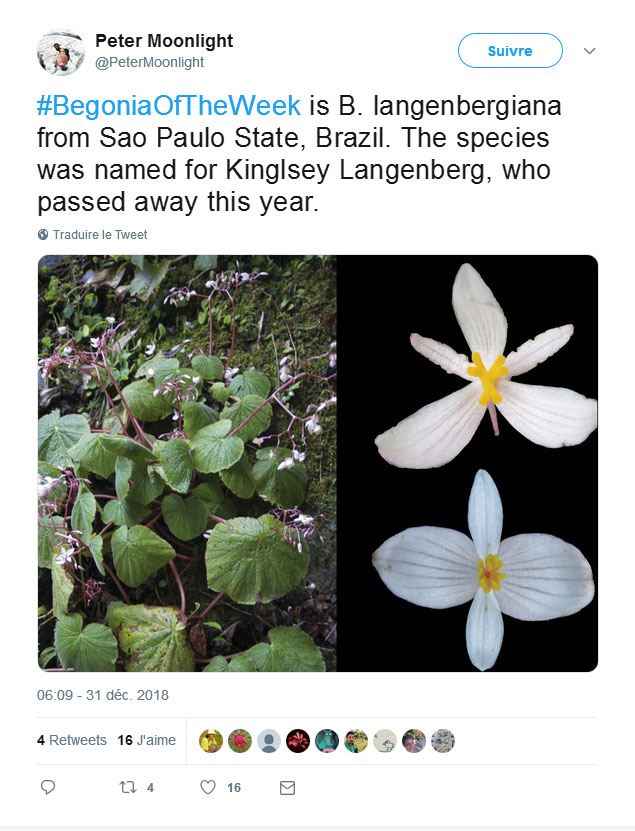La plante a été découverte dans la région d’Iporanga, au Morro Preto le mars 1986, puis dans la Vale do Ribeira le 18 Juin 1995, par une équipe composée de F. Chagas e Silva, M. C. Dias et L. H. S. Soares.
L’espèce a été dénommée et décrite en 2018 par Ludovic Kollmann dans Phytotaxa 381, numéro 1, pages 80 à 85.
L’espèce fait partie de la section Pritzelia, qui comprend environ 130 espèces d’Amérique du Sud caractérisées par leurs placentas entiers et la présence de cystolithes dans les cellules de la feuille.
L’épithète spécifique rend un hommage posthume à Kingsley Frederick Langenberg, qui a apporté une contribution importante à l’American Begonia Society (ABS) et a longtemps aidé l’auteur à corriger ses articles en anglais.
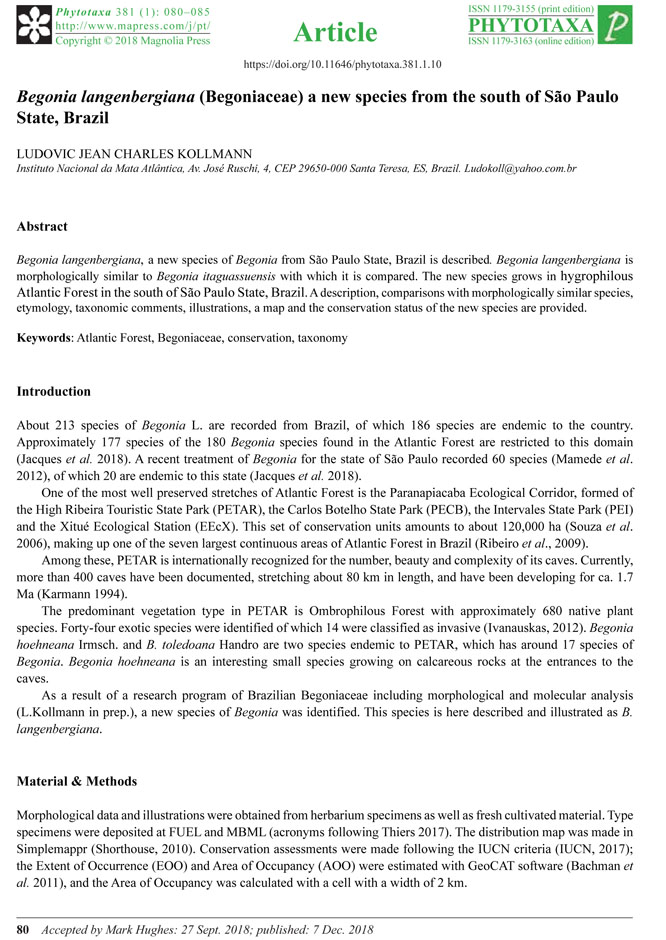
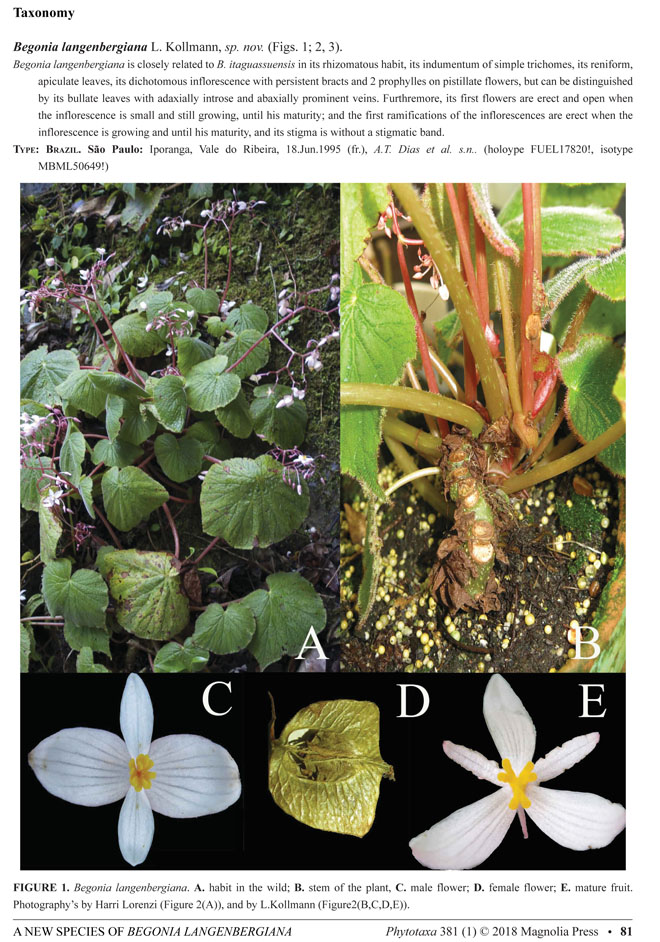
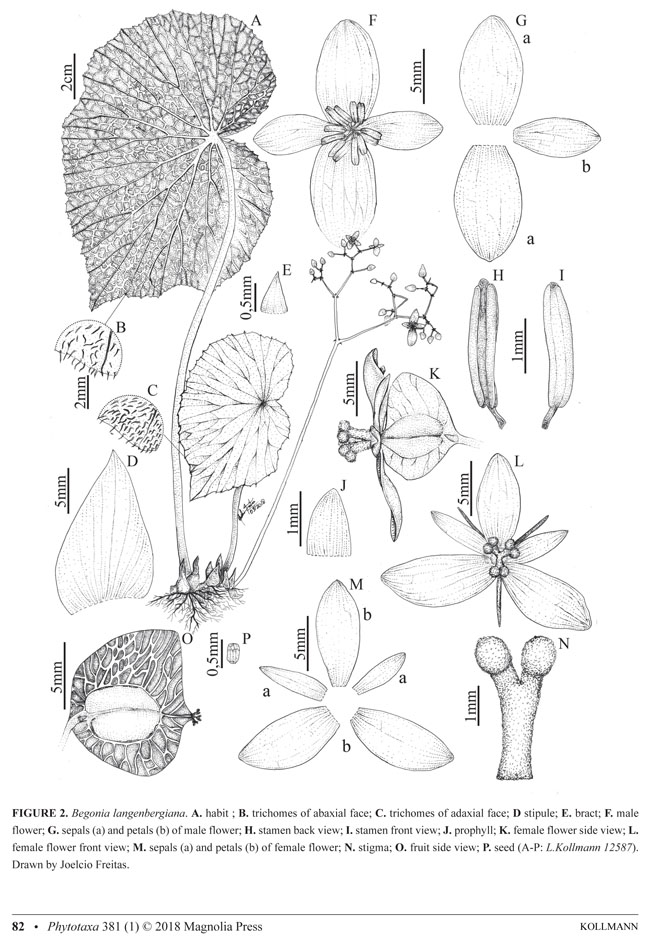

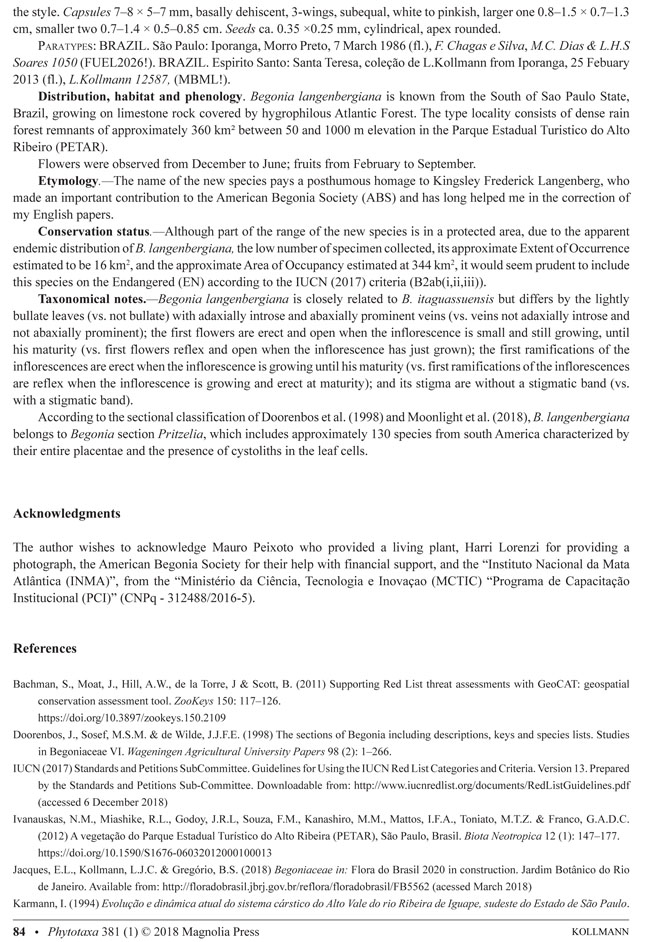
Begonia langenbergiana est connu dans le sud de l’État de Sao Paulo au Brésil et se développe sur des roches calcaires couvertes de forêts atlantiques hygrophiles. La localité type comprend des restes de forêt ombrophile denses d’environ 360 km², situés entre 50 et 1000 mètres d’altitude, dans le parc touristique du Haut-Ribeiro (PETAR). PETAR est internationalement reconnu pour le nombre, la beauté et la complexité de ses grottes. Actuellement, plus de 400 grottes ont été documentées, s’étendant sur environ 80 km de long. Le type de végétation prédominant dans le PETAR est la forêt ombrophile avec environ 680 espèces de plantes indigènes. Quarante-quatre espèces exotiques ont été identifiées, dont 14 ont été classées comme envahissantes (Ivanauskas, 2012). Begonia hoehneana Irmsch. et B. toledoana Handro sont deux espèces endémiques de PETAR, qui compte environ 17 espèces de Begonia. Begonia hoehneana est une petite espèce intéressante poussant sur les roches calcaires aux entrées des grottes.
Plante herbacée rhizomateuse, de 15 à 35 centimètres, trichomes simples. Tiges de 1 centimètre de diamètre, s’enracinant aux nœuds, vertes à rougeâtres, lenticellées, stipules persistantes, verdâtres à rougeâtre, triangulaires, long pétioles couverts de poils, feuilles asymétriques, réniformes, légèrement bullées à la base cordée se chevauchant, bord teintés de rouge, denticulés à dentés, nervures saillantes, couvertes de poils. Inflorescences originales, à 2 à 4 cymes dichotomiques, bractées persistantes, fleurs blanches, les fleurs femelle apparaissent longtemps après les fleurs mâles plus nombreuses. Les fleurs ont été observées de décembre à juin; fruits de février à septembre.
Begonia langenbergiana est étroitement apparentée à B. itaguassuensis mais se distingue par les feuilles légèrement bullées avec des nervures adaxiales et abaxiales proéminentes ; les premières fleurs sont dressées et ouvertes lorsque l’inflorescence est petite et en croissance, jusqu’à sa maturité ; les premières ramifications des inflorescences sont dressées lorsque l’inflorescence se développe jusqu’à sa maturité.
Culture facile en potée.
Multiplication par semis, bouture de rhizome.












The plant was discovered in the Iporanga region, at Morro Preto on March 1986, then in Vale do Ribeira on June 18, 1995, by a team composed of F. Chagas e Silva, M. C. Dias and L. H. S. Soares.
The species was named and described in 2018 by Ludovic Kollmann in Phytotaxa 381, number 1, pages 80 to 85.
The species is part of the Pritzelia section, which includes about 130 species of South America characterized by their entire placentas and the presence of cystoliths in the cells of the leaf.
The specific epithet makes a posthumous tribute to Kingsley Frederick Langenberg, who made an important contribution to the American Begonia Society (ABS) and has long helped the author to correct his articles in English.
Begonia langenbergiana is known in the south of the state of Sao Paulo in Brazil and develops on limestone rocks covered with hygrophilous Atlantic forests. The typical locality includes dense remains of rain forest of about 360 km², located between 50 and 1000 meters above sea level, in the tourist park of Upper Ribeiro (PETAR). PETAR is internationally recognized for the number, beauty and complexity of its caves. Currently, more than 400 caves have been documented, extending about 80 km long. The predominant type of vegetation in PETAR is the rain forest with about 680 native plant species. Forty-four exotic species have been identified, 14 of which have been classified as invasive (Ivanauskas, 2012). Begonia hoehneana Irmsch. and B. toledoana Handro are two endemic species of PETAR, which has about 17 species of Begonia. Begonia hoehneana is a small interesting species growing on the limestone rocks at the entrances of the caves.
Rhizomatous herbaceous plant, from 15 to 35 cm, simple trichomes. Stems 1 cm in diameter, rooted at nodes, green to reddish, lenticellate, evergreen stipules, greenish to reddish, triangular, long petioles covered with hair, asymmetrical leaves, kidney-shaped, slightly bubbly at the base corded overlapping, rim tinted red, denticulate to dentate, prominent veins, covered with hair. Original inflorescences, 2-4 dichotomous cymes, persistent bracts, white flowers, female flowers appear long after more male flowers. The flowers were observed from December to June; fruits from February to September.
Begonia langenbergiana is closely related to B. itaguassuensis but is distinguished by slightly bubbled leaves with prominent adaxial and abaxial veins; the first flowers are erect and open when the inflorescence is small and growing until it is mature; the first ramifications of the inflorescences are erect when the inflorescence develops until its maturity.
Easy cultivation in jar.
Multiplication by sowing, cutting of rhizome.
